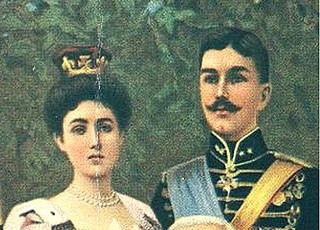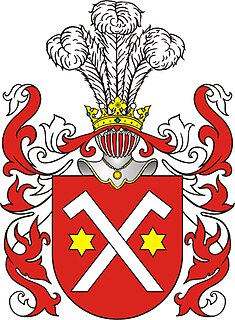Lists of dukedoms include:
Duke is a male title either of a monarch ruling over a duchy, or of a member of royalty, or nobility. As rulers, dukes are ranked below emperors, kings, grand princes, grand dukes, and sovereign princes. As royalty or nobility, they are ranked below princes of nobility and grand dukes. The title comes from French duc, itself from the Latin dux, 'leader', a term used in republican Rome to refer to a military commander without an official rank, and later coming to mean the leading military commander of a province. In most countries, the word duchess is the female equivalent.

A duchy, also called a dukedom, is a medieval country, territory, fief, or domain ruled by a duke or duchess, a high-ranking nobleman hierarchically second to the king or queen in European tradition. The term is used almost exclusively in Europe.

The Dukedom of Lancaster is an extinct English peerage. It was created three times during the Middle Ages but finally merged in the Crown when Henry V succeeded to the throne in 1413. Despite the extinction of the dukedom the title has continued to be used to refer to the reigning monarch of the United Kingdom in relation to Lancashire and the Duchy of Lancaster, an estate held separately from the Crown Estate for the benefit of the sovereign.

Duke of Edinburgh, named after the city of Edinburgh, Scotland, is a substantive title that has been created three times for members of the British royal family since 1726. It does not include any territorial landholdings and does not produce any revenue for the title holder.

Duke of Gloucester is a British royal title, often conferred on one of the sons of the reigning monarch. The first four creations were in the Peerage of England and the last in the Peerage of the United Kingdom; the current creation carries with it the subsidiary titles of Earl of Ulster and Baron Culloden.

Duke of Rothesay is a dynastic title of the heir apparent to the British throne, currently Prince Charles. Charles' wife Camilla, Duchess of Cornwall, is the current Duchess of Rothesay. Duke of Rothesay was a title of the heir apparent to the throne of the Kingdom of Scotland before 1707, of the Kingdom of Great Britain from 1707 to 1801, and now of the United Kingdom of Great Britain and Northern Ireland. It is the title mandated for use by the heir apparent when in Scotland, in preference to the titles Duke of Cornwall and Prince of Wales, which are used in the rest of the United Kingdom and overseas. The Duke of Rothesay also holds other Scottish titles, including those of Earl of Carrick, Baron of Renfrew, Lord of the Isles, and Prince and Great Steward of Scotland. The title is named after Rothesay on the Isle of Bute, Argyll and Bute, but is not associated with any legal entity or landed property, unlike the Duchy of Cornwall.
Doe, DoE, or DOE may refer to:

The title Duke of Braganza in the House of Braganza is one of the most important titles in the peerage of Portugal. Starting in 1640, when the House of Braganza acceded to the throne of Portugal, the male heir of the Portuguese Crown were known as Duke of Braganza, along with their style Prince of Beira or Prince of Brazil. The tradition of the heir to the throne being titled Duke of Braganza was revived by various pretenders after the establishment of the Portuguese Republic on 5 October 1910 to signify their claims to the throne.
Dukedom may refer to:
The Peerage of England comprises all peerages created in the Kingdom of England before the Act of Union in 1707. In that year, the Peerages of England and Scotland were replaced by one Peerage of Great Britain.

Duke of Richmond is a title in the Peerage of England that has been created four times in British history. It has been held by members of the royal Tudor and Stuart families.

Geysztor or Gieysztor - is a Polish coat of arms. It was used by several Szlachta families in the times of the Polish–Lithuanian Commonwealth.
From the early Middle Ages until early modern times, the nobility was the true basis of power for the English crown. The peerage was where the king would turn for military, judicial and administrative purposes, and the ruler who ignored his nobility, like Edward II, did so at great risk to his position. The peerage can perhaps best be compared to the cabinets of modern-day Prime Ministers or Presidents, though their power and responsibilities were much wider. The emergence of Parliament did not seriously erode the power of the nobility until, at the earliest, the 17th century.
Lists of dukes include:

Duke of Gloucester and Edinburgh was a British title in the Peerage of Great Britain; the sole creation carried with it the subsidiary title of Earl of Connaught.
In the British peerage, a royal duke is a member of the British royal family, entitled to the titular dignity of prince and the style of His Royal Highness, who holds a dukedom. Dukedoms are the highest titles in the British roll of peerage, and the holders of these particular dukedoms are princes of the blood royal. The holders of the dukedoms are royal, not the titles themselves. They are titles created and bestowed on legitimate sons and male-line grandsons of the British monarch, usually upon reaching their majority or marriage. The titles can be inherited but cease to be called "royal" once they pass beyond the grandsons of a monarch. As with any peerage, once the title becomes extinct, it may subsequently be recreated by the reigning monarch at any time.
A peerage is a legal system historically comprising various hereditary titles in a number of countries, and composed of assorted noble ranks.